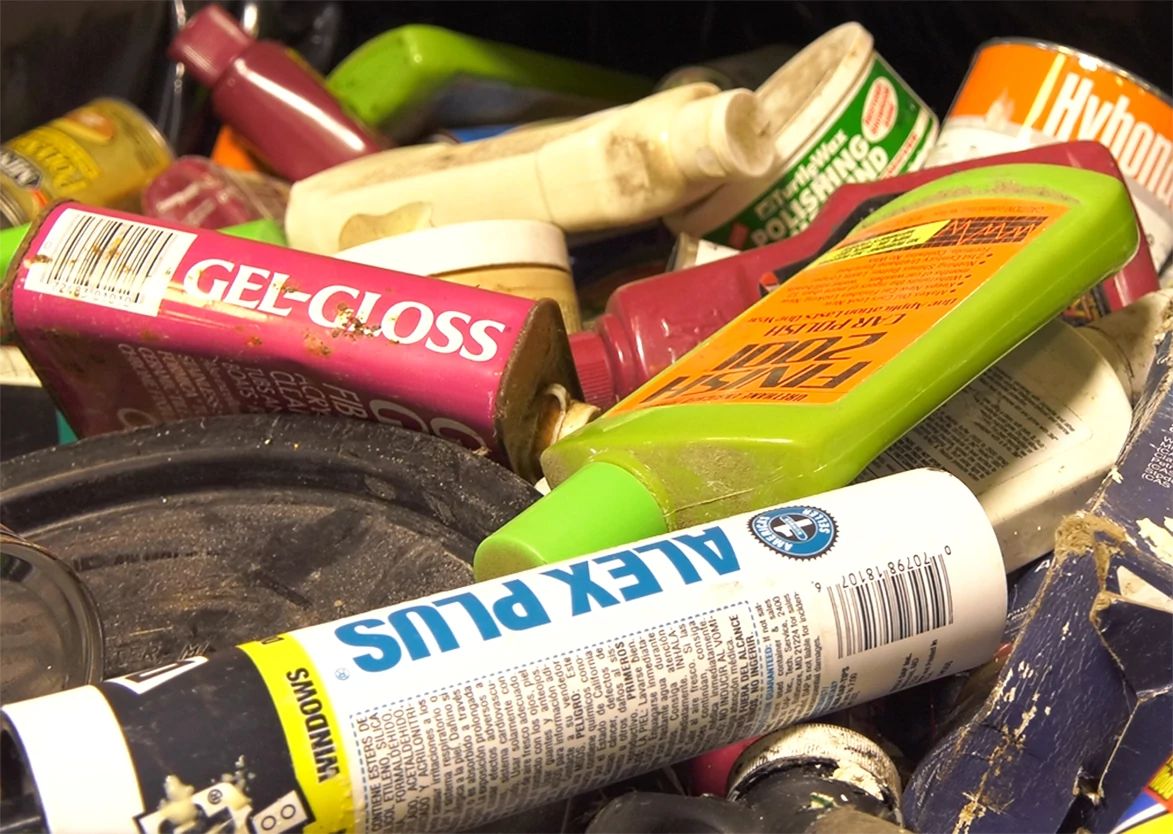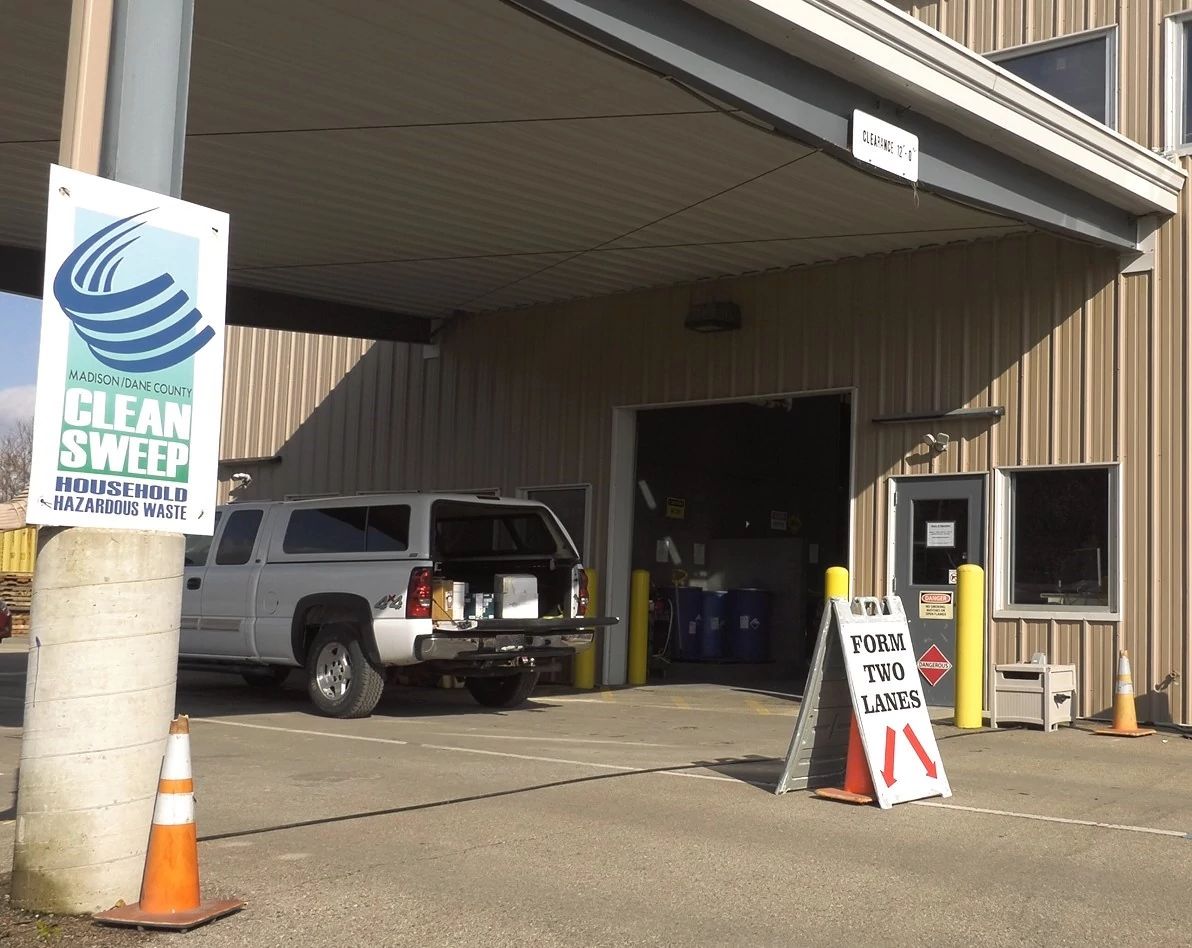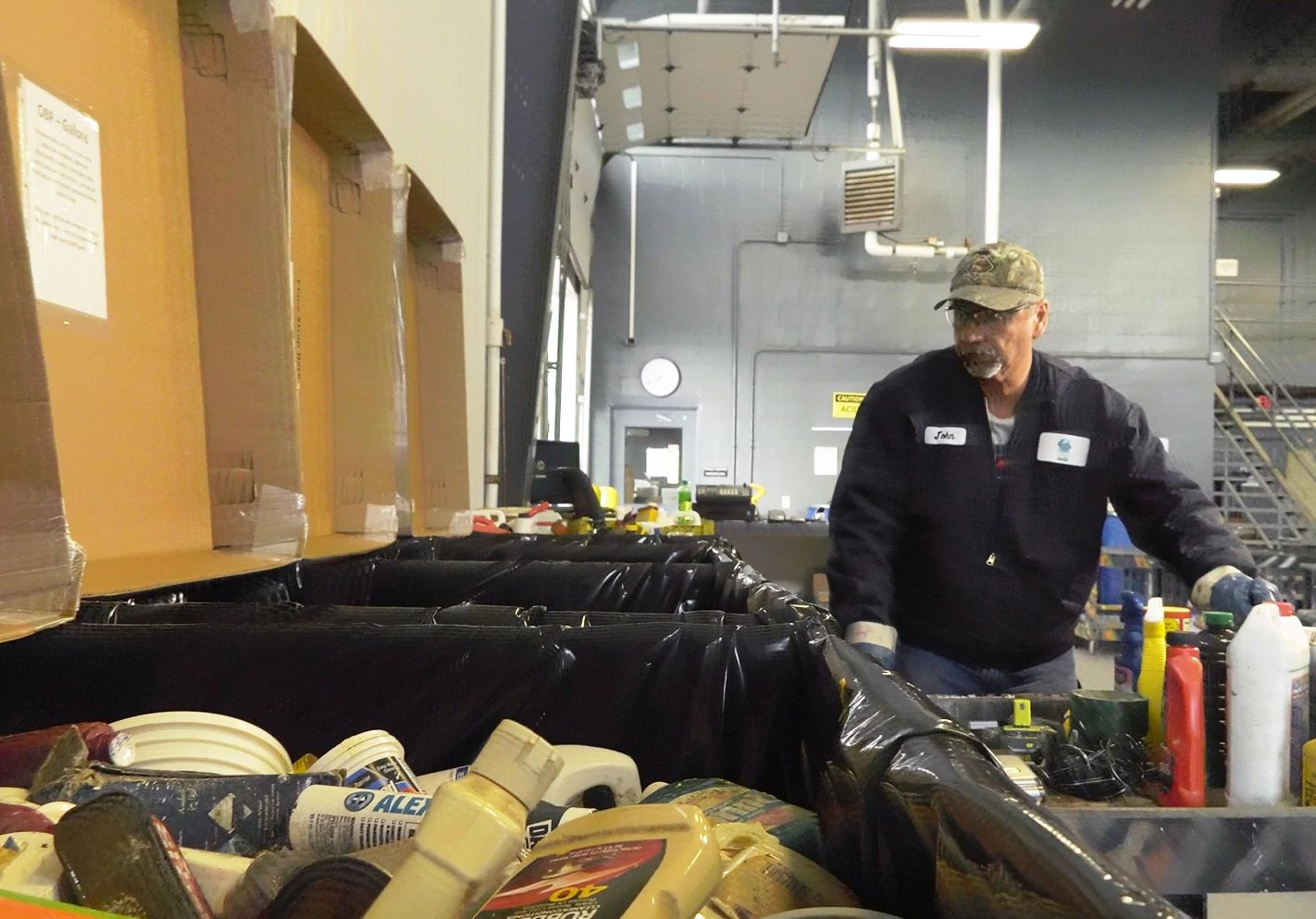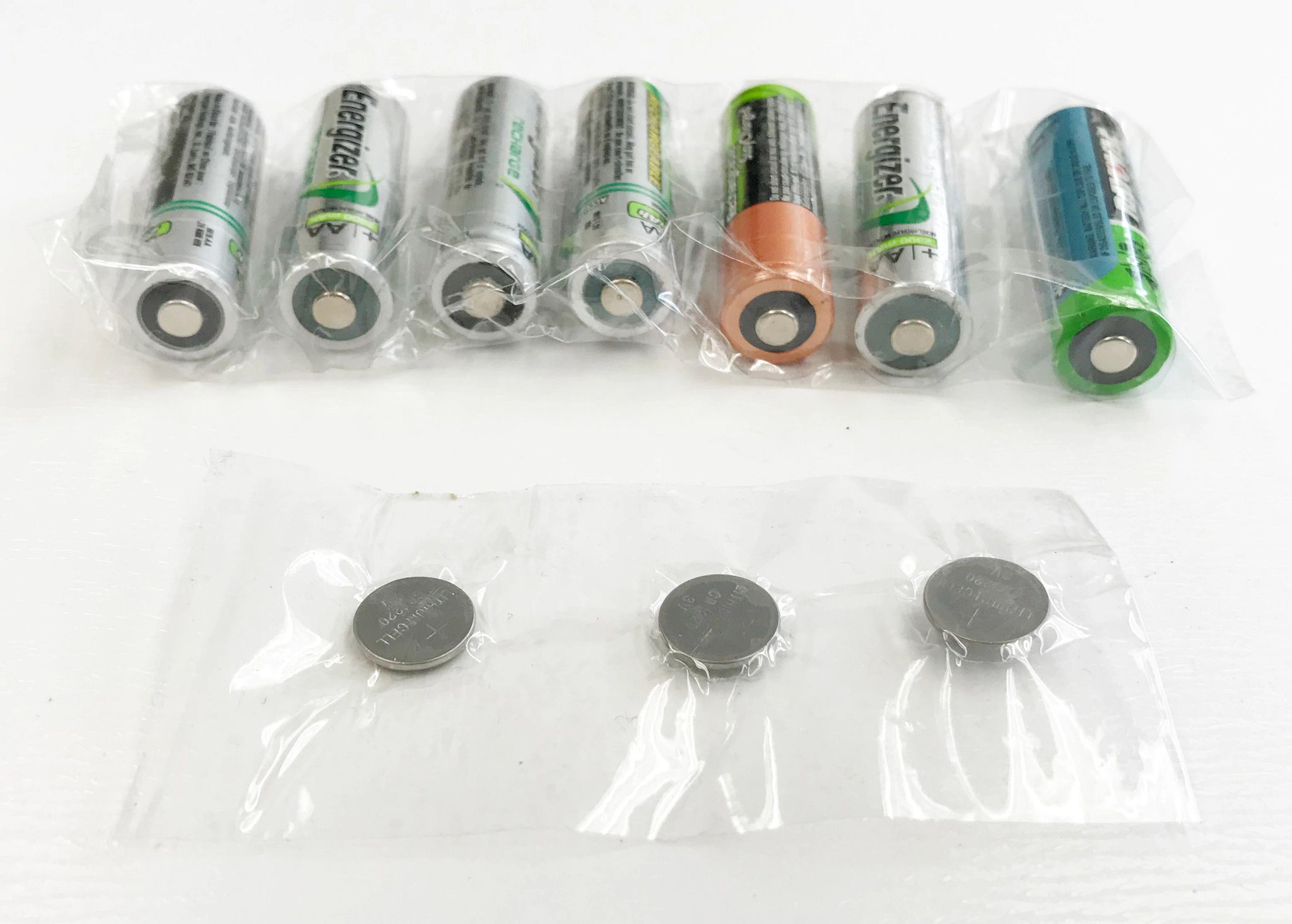Household hazardous waste
 Leftover products in any home can pose hazards when not stored or disposed of safely.
Leftover products in any home can pose hazards when not stored or disposed of safely.Household hazardous waste is any product found in your home, yard or garage generated by normal household activities (for example, routine home and yard maintenance) that can cause harm to human health or the environment when stored or disposed of improperly.
Household hazardous waste is not subject to Wisconsin's hazardous waste rules unless it is separated from normal household trash for management, but it is still potentially dangerous when stored or disposed of improperly.
Information on this page and in the Household Hazardous Waste Guide (WA-1719) is intended to help residents identify, reduce and safely dispose of household hazardous waste.
- Household Hazardous Waste Management Guide (WA-1719) [PDF]
- Guía de gestión de residuos peligrosos del hogar (WA-2012) [PDF]
Collection and exchange programs
 Some businesses, collection sites and events will charge a flat fee for certain items. The DNR recommends calling ahead to verify accepted items, hours and fees.
Some businesses, collection sites and events will charge a flat fee for certain items. The DNR recommends calling ahead to verify accepted items, hours and fees.Residents can take many household hazardous wastes to community collection points, which will send the waste for proper treatment or disposal. Residents may also be able to return some items to retailers. For many communities, one-day collection events may be the closest option. Many one-day events occur in spring, summer or fall.
Some permanent collection sites have product exchange programs where household products that are still usable, such as paint, thinners, solvents and pesticides, are available and free to the public.
The Wisconsin Department of Agriculture, Trade and Consumer Protection’s Clean Sweep program provides a list of communities with collection sites and events. You can also contact your community or county solid waste department for information about additional collection locations in your area.
- Wisconsin Clean Sweep (DATCP) [exit DNR]
- Local governments that host Clean Sweep collection events [exit DNR]
DNR notification requirement for collection programs
Household hazardous waste collection sites and events are required to notify the Department of Natural Resources before collecting waste.
Reducing household hazardous waste
Replacing products with less harmful alternatives, only buying what can be used entirely, and checking what is already in your home or garage before purchasing more products are ways to reduce household hazardous waste.
The U.S. Environmental Protection Agency's Safer Choice program helps consumers find products that are safer for human health and the environment, including many alternatives to products that become household hazardous waste.
Disposal guide
 Household hazardous waste facilities sort waste items by type.
Household hazardous waste facilities sort waste items by type.The disposal guide and tables below provide general information. Always check individual product labels. Using products for their intended purpose is often the simplest solution. Otherwise, the tables indicate the preferred handling method(s).
Pitch it: Dry waste until it is solid and pitch it in the trash.
Pour it: Flush cleaners with lots of water when pouring them down the drain. Never pour household hazardous waste in a septic system or storm drain.
Take it: Find a collection program and store waste safely until collection. Keeping products in their original containers help household hazardous waste facilities properly manage the waste.
Banned from the trash: Wisconsin law prohibits everyone, including households, from disposing of these items in the trash.
Car care
Car and automotive care
| Household hazardous waste | Pitch it | Pour it | Take it | Banned from the trash | Additional information |
|---|---|---|---|---|---|
| Antifreeze | X |
|
|||
| Automotive type batteries | X | X |
Battery dealers will accept automotive batteries for recycling. See Proper handling of used batteries for more information. |
||
| Brake fluid | X |
See Used Oil Management [PDF] for more information. |
|||
| Carburetor cleaner | X | ||||
| Degreasers | X | ||||
| Gasoline and fuels | X | ||||
| Motor oil (used) | X | X |
See Used Oil Management [PDF] and/or Recycling motor oil for more information. |
||
| Tires | X | X |
See Waste tires for more information. |
||
| Transmission fluid | X |
See Used Oil Management [PDF] for more information. |
|||
| Windshield washer | X |
Cleaners
Household cleaners
| Household hazardous waste | Pitch it | Pour it | Take it | Banned from the trash | Additional information |
|---|---|---|---|---|---|
| Cleaner with ammonia | X |
Never mix products containing ammonia with those containing bleach, as it can cause a harmful chemical reaction. |
|||
| Cleaner with bleach | X |
Never mix products containing ammonia with those containing bleach, as it can cause a harmful chemical reaction. |
|||
| Concrete cleaners (acid) | X | ||||
| Disinfectants | X | ||||
| Drain cleaner | X |
A plunger, drain snake and mixing vinegar with baking soda is a nonhazardous solution. |
|||
| Metal cleaners | X |
Keep sealed when storing. |
|||
| Oven cleaners | X | X |
Using water and steel wool is a nonhazardous alternative. |
||
| Polish/spot removers | X | X | |||
| Polish with solvents | X |
Keep sealed when storing. Solvent-containing products are labelled as "flammable," "combustible" or "containing petroleum distillates." |
|||
| Pool chemicals | X | Keep sealed when storing. | |||
| Toilet/tub/tile cleaner | X | X |
Baking soda and vinegar is a nonhazardous alternative. |
Home projects
Paints, stains and homewares
| Household hazardous waste | Pitch it | Pour it | Take it | Banned from the trash | Additional information |
|---|---|---|---|---|---|
| Adhesives/glues, water-based | X | ||||
| Adhesives with solvents | X |
Keep sealed when storing. Solvent-containing products are labelled as "flammable," "combustible" or "containing petroleum distillates." |
|||
| Caulk, grout, putty, spackle | X | ||||
| Floor/wax stripper | X | Keep sealed when storing. | |||
| Furniture stripper | X | Keep sealed when storing. | |||
| Paint, latex-based | X | ||||
| Paint, oil-based | X | Keep sealed when storing. | |||
| Paint remover/thinner | X | Keep sealed when storing. | |||
| Sealers | X | Keep sealed when storing. | |||
| Stain, varnish, lacquer | X | Keep sealed when storing. | |||
| Turpentine | X | Keep sealed when storing. | |||
| Wood preservatives | X | Keep sealed when storing. |
Pesticides
Pesticides, weed killers and poisons
| Household hazardous waste | Pitch it | Pour it | Take it | Banned from the trash | Additional information |
|---|---|---|---|---|---|
| Fertilizer with weed killer | X | Keep sealed when storing. | |||
| Flea spray | X | Keep sealed when storing. | |||
| Insect/bug killer | X | Keep sealed when storing. | |||
| Mothballs | X | Keep sealed when storing. | |||
| Rat/rodent poison | X |
Keep sealed when storing. Snap traps are a nonhazardous alternative. |
|||
| Weed killer | X |
Keep sealed when storing. |
Pressurized containers
Pressurized containers
| Household hazardous waste | Pitch it | Pour it | Take it | Banned from the trash | Additional information |
|---|---|---|---|---|---|
| Aerosol cans | X | Keep sealed when storing. | |||
| Propane tanks (refillable) | X |
Refill at supplier. Keep sealed when storing. |
|||
| Propane tanks (small, nonrefillable) | X | Use entire contents of tank so that it is empty. Single-use all-steel cylinders can be recycled at a scrap metal operation, but they must first be completely empty. Cylinders should NOT be placed in your curbside recycling. |
Other items
Other hazardous materials in the home
 Certain household battery types can pose a fire risk.
Certain household battery types can pose a fire risk.The DNR offers information on how to safely dispose of other potentially hazardous household waste items. These include:
- pharmaceuticals (including medicine, prescription drugs);
- medical sharps (including needles, syringes and lancets);
- construction and demolition debris (materials coated with leaded paint, asbestos);
- electronics (computers, cellphones, TVs, etc.);
- batteries; and
- light bulbs.
| Household hazardous waste | Pitch it | Pour it | Take it | Banned from the trash | Additional information |
|---|---|---|---|---|---|
| Ammunition/bullets | X | Store in a place free from heat or sparks and consult local law enforcement. | |||
| Marine flares | X | Store in a place free from heat or sparks and take to a collection site. | |||
| Empty hazard containers | X | Once completely emptied, containers may be placed in regular trash. | |||
| Fertilizer without weed killer | X |
See Composting for alternative ideas. |
|||
| Lighter fluid | X | Keep in safe, sealed place, away from heat. | |||
| Mercury | X |
Keep sealed when storing. |
|||
| Paint (artist or hobby paint) | X | ||||
| Smoke detectors | X |
First Alert/BRT, Kiddie, Sears, System Sensors, USI Electric have take-back programs. |
|||
| Thermometers (mercury) | X |
Keep sealed when storing. |
Vaping devices
E-cigarettes and vaping devices
E-cigarettes or vaping devices are electronic nicotine delivery systems. Examples include vapes, vaporizers, vape pens, hookah pens and electronic cigarettes (e-cigarettes or e-cigs). These delivery devices vaporize a concentrated oil containing nicotine and are powered by a lithium battery.
Health and fire risks
Nicotine can be fatal to humans in low doses. Unlike nicotine gums, lozenges or patches approved by the U.S. Food and Drug Administration as over-the-counter nicotine replacement therapies, the concentration of nicotine in vape juice may be high enough to cause health risks, particularly for small children and pets. Exposure can occur through ingestion (swallowing) or dermal (skin) exposure.
Lithium batteries that power most e-cigarettes and other vaping devices are a potential fire hazard. When these batteries have been crushed, damaged, exposed to high temperatures, or short-circuited by contact with metal or other batteries, they can react and produce fires or explosions.
Safe disposal options
Under current state law, household-generated e-cigarettes and other vaping devices may be disposed of in the regular garbage. However, because of the battery fire risk, the DNR strongly encourages households to consider the disposal alternatives described below.
Battery removal
Because of the fire risk from damaged lithium batteries, the DNR does not recommend that households remove batteries from these devices unless the battery is designed to be removed by the user (replaceable battery). If a battery is designed to be removed, it can be managed separately and recycled. For more information, visit the DNR’s batteries webpage.
Used/spent devices with or without batteries
Households may be able to bring used vaping devices or components, including those with batteries, to household hazardous waste or Clean Sweep collection facilities or events. This presumes the device was used for its intended purpose, is emptied of liquid and cannot be refilled or reused. Please check a facility/event website or contact the facility/event organizers ahead of time to make sure they can accept these devices.
- Wisconsin Clean Sweep (DATCP) [exit DNR]
- Local governments hosting 2021 Clean Sweep collection events [exit DNR]
Unused or partially used devices with removable batteries, and cartridges
If the e-cigarette, vaping device or cartridge is not completely used (still contains vaping liquid), and the battery is designed to be removed, the device without the battery and cartridges can be taken to a drug take back location for collection and disposal.
Do not add devices with batteries to pharmaceutical drop boxes, as the buttons on the units can be easily pushed, causing a fire.
Unused or partially used devices with batteries
Some household hazardous waste or Clean Sweep collection programs may be able to accept nicotine-containing wastes, including vaping devices. If you have a vaping device with non-removable batteries that still contains vaping liquid, contact a collection facility ahead of time to find out whether it can accept the device.
Device take back programs
Some e-cigarette manufacturers have implemented their own initiatives. Contact your device manufacturer to find out if they have a current take back program
